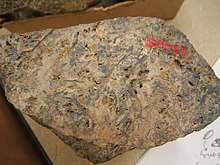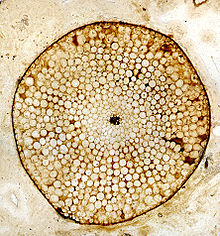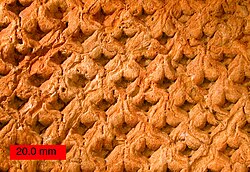Paleobotany
This articleneeds additional citations forverification.(October 2011) |

| Part of a series on |
| Paleontology |
|---|
 |
|
Paleontology Portal Category |
Paleobotany,also spelled aspalaeobotany,is the branch ofbotanydealing with the recovery and identification ofplantremains fromgeologicalcontexts, and their use for the biological reconstruction of past environments (paleogeography), and theevolutionary history of plants,with a bearing upon theevolution of lifein general. A synonym ispaleophytology.It is a component ofpaleontologyandpaleobiology.The prefixpalaeo-orpaleo-means "ancient, old",[1]and is derived from theGreekadjectiveπαλαιός,palaios.[2]Paleobotany includes the study ofterrestrial plantfossils,as well as the study ofprehistoricmarinephotoautotrophs,such asphotosyntheticalgae,seaweedsorkelp.A closely related field ispalynology,which is the study of fossilized andextantsporesandpollen.
Paleobotany is important in the reconstruction of ancientecologicalsystems andclimate,known aspaleoecologyandpaleoclimatologyrespectively. It is fundamental to the study of green plantdevelopmentandevolution.Paleobotany is a historical science much like its adjacent, paleontology. Because of the understanding that paleobotany gives to archeologists, it has become important to the field ofarchaeologyas a whole. primarily for the use ofphytolithsinrelative datingand inpaleoethnobotany.[3]
The study and discipline of paleobotany was seen as far back as the 19th century. Known as the “Father of Paleobotany”, French botanistAdolphe-Theodore Brongniartwas a sufficient figure in this emergence of Paleobotany, known for his work on the relationship between the living and extinct plant life. This work not only progressed paleobotany but also the understanding of the earth and its longevity in actuality and theorganic matterthat existed over the earth’s timeline. Paleobotany also succeeded in the hands of German paleontologistErnst Friedrich von Schlothiem,and Czech nobleman and scholar,Kaspar Maria von Sternberg.[4][5]
Related Sciences[edit]
Paleoecology[edit]
As paleobotany is the specification of fossilizedplant lifeand the environment in which they thrived in,paleoecologyis the study of all once-livingorganismsand the interactions held in the environments they once existed in, before becomingextinct.[6]
Paleoecology is a similar study to that ofpaleontology,but paleoecology uses moremethodologyfrom thebiological sciencesandgeological sciences[7]rather than from ananthropologicalstandpoint as paleontologists do.
Paleopalynology[edit]
Paleopalynology,more commonly known aspalynology,is the science and study of ancient palynomorphs: particles sized between 5 and 500 micrometers.[8]This would be an inclusion ofpollenandsporesand any other micro-organic matter. Paleopalynology is simply paleobotany on a much smaller scale, the two in close association with each other.
Similar to paleobotany, we can tell a great deal of information about the environment andbiomeat the time theseparticlesexisted prehistorically. These particles also help geologists identify and date therock strataofsedimentary rocks.It is also used to find natural oils andgaswithin these rock layers forextraction.[9]Besides uncovering documentation of our past environmental conditions, palynology can also tell us about animal diets, historical standings of humanallergies,and reveal evidence in crime cases.
Overview of the paleobotanical record[edit]
Macroscopic remainsof truevascular plantsare first found in the fossil record during theSilurianPeriod of thePaleozoicera. Some dispersed, fragmentary fossils of disputed affinity, primarily spores andcuticles,have been found in rocks from theOrdovicianPeriod inOman,and are thought to derive fromliverwort- ormoss-grade fossil plants.[10]

An important early land plant fossil locality is theRhynie chert,found outside the village ofRhynieinScotland.The Rhynie chert is an EarlyDevoniansinter (hot spring) deposit composed primarily ofsilica.It is exceptional due to its preservation of several differentcladesof plants, from mosses andlycophytesto more unusual, problematic forms. Many fossil animals, includingarthropodsandarachnids,are also found in the Rhynie chert, and it offers a unique window into the history of early terrestrial life.
Plant-derived macrofossils become abundant in the Late Devonian includingtreetrunks,fronds,androots.The earliest tree was once thought to beArchaeopteris,which bears simple,fern-likeleavesspirally arranged on branches atop aconifer-liketrunk,[11]although it is now known to be the recently discoveredWattieza.[12]
Widespreadcoalswamp deposits across North America and Europe during theCarboniferousPeriod contain a wealth of fossils containingarborescent lycopodsup to 30 m tall, abundantseed plants,such as conifers andseed ferns,and countless smaller,herbaceous plants.
Angiosperms (flowering plants) evolved during theMesozoic,and flowering plant pollen and leaves first appeared during the EarlyCretaceous,approximately 130 million years ago.
Plant fossils[edit]
This section includes a list of generalreferences,butit lacks sufficient correspondinginline citations.(May 2023) |
A plant fossil is any preserved part of a plant that has long since died. Such fossils may be prehistoric impressions that are many millions of years old, or bits ofcharcoalthat are only a few hundred years old. Prehistoric plants are various groups of plants that lived before recordedhistory(before about3500 BC).
Preservation of plant fossils[edit]

Plant fossils can be preserved in a variety of ways, each of which can give different types of information about the original parent plant. These modes of preservation may be summarised in a paleobotanical context as follows.
- Adpressions (compressions – impressions).These are the most commonly found type of plant fossil. They provide good morphological detail, especially of dorsiventral (flattened) plant parts such as leaves. If the cuticle is preserved, they can also yield fine anatomical detail of the epidermis. Little other detail of cellular anatomy is normally preserved.

Rhynia,Lower Devonian Rhynie Chert, Scotland, UK. Transverse section through a stem preserved as a silica petrifaction, showing preservation of cellular structure. - Petrifactions (permineralisations or anatomically preserved fossils).These provide fine detail of the cell anatomy of the plant tissue. Morphological detail can also be determined by serial sectioning, but this is both time consuming and difficult.
- Moulds and casts.These only tend to preserve the more robust plant parts such as seeds or woody stems. They can provide information about the three-dimensional form of the plant, and in the case of casts of tree stumps can provide evidence of the density of the original vegetation. However, they rarely preserve any fine morphological detail or cell anatomy. A subset of such fossils arepith casts,where the centre of a stem is either hollow or has delicate pith. After death, sediment enters and forms a cast of the central cavity of the stem. The best known examples of pith casts are in the Carboniferous Sphenophyta (Calamites) and cordaites (Artisia).
CrossothecahughesianaKidston, Middle Pennsylvanian, Coseley, near Dudley, UK. A lyginopteridalean pollen organ preserved as an authigenic mineralization (mineralizedin situ). Specimen in Sedgwick Museum, Cambridge, UK. - Authigenic mineralisations.These can provide very fine, three-dimensional morphological detail, and have proved especially important in the study of reproductive structures that can be severely distorted in adpressions. However, as they are formed in mineral nodules, such fossils can rarely be of large size.
- Fusain.Fire normally destroys plant tissue but sometimes charcoalified remains can preserve fine morphological detail that is lost in other modes of preservation; some of the best evidence of early flowers has been preserved in fusain. Fusain fossils are delicate and often small, but because of their buoyancy can often drift for long distances and can thus provide evidence of vegetation away from areas of sedimentation.
Fossil-taxa[edit]
Plant fossils almost always represent disarticulated parts of plants; even small herbaceous plants are rarely preserved whole. The few examples of plant fossils that appear to be the remains of whole plants are in fact incomplete as the internal cellular tissue and fine micromorphological detail is normally lost during fossilization. Plant remains can be preserved in a variety of ways, each revealing different features of the original parent plant.[13]
Because of this, paleobotanists usually assign different taxonomic names to different parts of the plant in different modes of preservation. For instance, in the subarborescent Palaeozoicsphenophytes,an impression of a leaf might be assigned to the genusAnnularia,a compression of a cone assigned toPalaeostachya,and the stem assigned to eitherCalamitesorArthroxylondepending on whether it is preserved as a cast or a petrifaction. All of these fossils may have originated from the same parent plant but they are each given their own taxonomic name. This approach to naming plant fossils originated with the work ofAdolphe-Théodore Brongniart.[14]
For many years this approach to naming plant fossils was accepted by paleobotanists but not formalised within theInternational Rules of Botanical Nomenclature.[15]Eventually,Thomas (1935)andJongmans, Halle & Gothan (1935)proposed a set of formal provisions, the essence of which was introduced into the 1952International Code of Botanical Nomenclature.[16]These early provisions allowed fossils representing particular parts of plants in a particular state of preservation to be placed in organ-genera. In addition, a small subset of organ-genera, to be known as form-genera, were recognised based on the artificial taxa introduced by Brongniart mainly for foliage fossils. The concepts and regulations surrounding organ- and form-genera were modified within successive codes of nomenclature, reflecting a failure of the paleobotanical community to agree on how this aspect of plant taxonomic nomenclature should work (a history reviewed by Cleal and Thomas in 2020[17]). The use of organ- and fossil-genera was abandoned with theSt Louis Code,and replaced by "morphotaxa".[18]
The situation in theVienna Codeof 2005 was that any plant taxon whose type is a fossil, exceptdiatoms,can be described as amorphotaxon,a particular part of a plant preserved in a particular way.[19]Although the name is always fixed to the type specimen, the circumscription (i.e. range of specimens that may be included within the taxon) is defined by the taxonomist who uses the name. Such a change in circumscription could result in an expansion of the range of plant parts or preservation states that could be incorporated within the taxon. For instance, a fossil-genus originally based on compressions of ovules could be used to include the multi-ovulate cupules within which the ovules were originally borne. A complication can arise if, in this case, there was an already named fossil-genus for these cupules. If paleobotanists were confident that the type of the ovule fossil-genus and of the cupule fossil-genus could be included in the same genus, then the two names would compete as to being the correct one for the newly emended genus. In general, there would be competing priority whenever plant parts that had been given different names were discovered to belong to the same species. It appeared that morphotaxa offered no real advantage to paleobotanists over normal fossil-taxa and the concept was abandoned with the 2011 botanical congress and the 2012International Code of Nomenclature for algae, fungi, and plants.
Fossil groups of plants[edit]



Some plants have remained almost unchanged throughout earth's geological time scale.Horsetailshad evolved by the Late Devonian,[20]early ferns had evolved by theMississippian,conifersby thePennsylvanian.Some plants of prehistory are the same ones around today and are thusliving fossils,such asGinkgo bilobaandSciadopitys verticillata.Other plants have changed radically, or became extinct.
Examples of prehistoric plants are:
- Araucaria mirabilis
- Archaeopteris
- Calamites
- Dillhoffia
- Glossopteris
- Hymenaea protera
- Nelumbo aureavallis
- Pachypteris
- Palaeoraphe
- Peltandra primaeva
- Protosalvinia
- Trochodendron nastae
Notable paleobotanists[edit]
- Edward W. Berry(1875–1945),paleoecologyandphytogeography[21]
- William Gilbert Chaloner(1928–2016)[22]
- Isabel Cookson(1893–1973), early vascular plants,palynology[23]
- Margaret Bryan Davis,(1931-), American paleoecologist and palynologist[24]
- Dianne Edwards(1942–), colonization of land by early terrestrial floras[25][26]
- Constantin von Ettingshausen(1826–1897), Tertiary floras
- Thomas Maxwell Harris(1903–1983), Mesozoic plants of Jameson Land (Greenland) and Yorkshire.[27]
- Robert Kidston(1852–1924), early land plants, Devonian and Carboniferous floras, and their use in stratigraphy
- Ana María Ragonese(1928–1999), fossil wood morphology, spermatophytes[28]
- Ethel Ida Sanborn(1883–1952), extinct flora of Oregon and the Western United States
- Birbal Sahni(1891–1949), Revision of Indian Gondwana Plants
- Dunkinfield Henry Scott(1854–1934), analysis of the structures of fossil plants
- Kaspar Maria von Sternberg(1761–1838), the "father of paleobotany"
- Franz Unger(1800–1870), pioneer in plant physiology, phytotomy and soil science
- Jack A. Wolfe(1936–2005), Tertiary paleoclimate of western North America
- Gilbert Arthur Leisman(1924–1996), known for work on Carboniferous lycophytes of central North America.
See also[edit]
- Cryptospores
- Evolutionary history of plants
- Paleophycology
- Prehistoric life
- Timeline of plant evolution
References[edit]
- ^Stearn, W.T. (2004).Botanical Latin(4th (p/b) ed.). Portland, Oregon: Timber Press. p. 460.ISBN978-0-7153-1643-6.
- ^Liddell, Henry George & Scott, Robert (1940)."παλαιός".A Greek-English Lexicon.Oxford: Clarendon Press.Retrieved2019-07-16.
- ^Cabanes, D. (2020). Phytolith Analysis in Paleoecology and Archaeology. In Interdisciplinary Contributions to Archaeology (pp. 255-288) doi: 10.1007/978-3-030-42622-4_11
- ^"Brongniart, Adolphe-Théodore".www.encyclopedia.com.Encyclopedia.com: FREE online dictionary.Retrieved22 February2017.
- ^Cleal, Christopher J.; Lazarus, Maureen; Townsend, Annette (2005). "Illustrations and illustrators during the 'Golden Age' of palaeobotany: 1800–1840". In Bowden, A. J.; Burek, C. V.; Wilding, R. (eds.).History of palaeobotany: selected essays.London: Geological Society of London. p.41.ISBN9781862391741.
- ^"Paleoecology".Digital Atlas of Ancient Life.Retrieved2023-11-13.
- ^"Paleoecology | Encyclopedia.com".www.encyclopedia.com.Retrieved2023-11-13.
- ^Traverse, Alfred (2008).Paleopalynology.Topics in geobiology (2. ed., printed with corr ed.). Dordrecht: Springer.ISBN978-1-4020-5609-3.
- ^"Palynology".Paleobotany + Palynology.Retrieved2023-11-13.
- ^Wellman, Charles H.; Osterloff, Peter L. & Mohiuddin, Uzma (2003),"Fragments of the Earliest Land Plants"(PDF),Nature,425(6955): 282–285,Bibcode:2003Natur.425..282W,doi:10.1038/nature01884,PMID13679913,S2CID4383813
- ^Meyer-Berthaud, Brigitte; Scheckler, S.E. & Wendt, J. (1999), "Archaeopterisis the Earliest Modern Tree ",Nature,398(6729): 700–701,Bibcode:1999Natur.398..700M,doi:10.1038/19516,S2CID4419663
- ^Speer, Brian R. (10 June 1995),The Devonian Period,retrieved12 May2012
- ^Darrah, William C. (1936)."The Peel Method in Paleobotany".Botanical Museum Leaflets, Harvard University.4(5): 69–83.doi:10.5962/p.295100.ISSN0006-8098.JSTOR41762635.
- ^Brongniart (1822)
- ^Briquet, J. (1906),Règles internationales de la nomenclature botanique adoptées par le Congrès International de Botanique de Vienne 1905,Jena: Fischer,OCLC153969885
- ^Lanjouw et al. 1952
- ^Cleal & Thomas 2010
- ^Greuter et al. 2000
- ^McNeill 2006
- ^Elgorriaga, A.; Escapa, I.H.; Rothwell, G.W.; Tomescu, A.M.F.; Cúneo, N.R. (2018)."Origin of Equisetum: Evolution of horsetails (Equisetales) within the major euphyllophyte clade Sphenopsida".American Journal of Botany.105(8): 1286–1303.doi:10.1002/ajb2.1125.PMID30025163.
- ^"Edward Berry".www.nasonline.org.Retrieved2024-01-07.
- ^"Professor William Gilbert Chaloner (Bill) and his contributions to palaeobotany – International Organisation of Palaeobotany".Retrieved2024-01-07.
- ^Dettmann, Mary E.,"Isabel Clifton Cookson (1893–1973)",Australian Dictionary of Biography,Canberra: National Centre of Biography, Australian National University,retrieved2024-01-07
- ^"Margaret Bryan Davis | Biography & Facts | Britannica".www.britannica.com.Retrieved2024-03-06.
- ^"Harvard University Herbaria & Libraries".kiki.huh.harvard.edu.Retrieved2024-01-07.
- ^"Dianne Edwards | Plant Fossil Names".www.plantfossilnames.org.Retrieved2024-01-07.
- ^Chaloner, William Gilbert (1985-11-01)."Thomas Maxwell Harris, 8 January 1903 - 1 May 1983".Biographical Memoirs of Fellows of the Royal Society.31:228–260.doi:10.1098/rsbm.1985.0009.ISSN0080-4606.
- ^Bacigalupo, Nélida M.; Guaglianone, E. Rosa (1999)."Ana María Ragonese (1928-1999)".Darwiniana.37(3/4): 351.ISSN0011-6793.JSTOR23223919.
Further reading[edit]
- Brongniart, A. (1822), "Sur la classification et la distribution des végétaux fossiles en général, et sur ceux des terrains de sediment supérieur en particulier",Mém. Mus. Natl. Hist. Nat.,8:203–240, 297–348
- Cleal, C.J. & Thomas, B.A. (2010), "Botanical nomenclature and plant fossils",Taxon,59:261–268,doi:10.1002/tax.591024
- Greuter, W.; McNeill, J.; Barrie, F R.; Burdet, H.M.; Demoulin, V.; Filgueiras, T.S.; Nicolson, D.H.; Silva, P.C.; Skog, J.E.; Turland, N.J. & Hawksworth, D.L. (2000),International Code of Botanical Nomenclature (Saint Louis Code),Königstein.: Koeltz Scientific Books,ISBN978-3-904144-22-3
- Jongmans, W.J.; Halle, T.G. & Gothan, W. (1935),Proposed additions to the International Rules of Botanical Nomenclature adopted by the fifth International Botanical Congress Cambridge1930,Heerlen,OCLC700752855
- Lanjouw, J.; Baehni, C.; Merrill, E.D.; Rickett, H.W.; Robyns, W.; Sprague, T.A. & Stafleu, F.A. (1952),International Code of Botanical Nomenclature: Adopted by the Seventh International Botanical Congress; Stockholm, July 1950,Regnum Vegetabile 3, Utrecht: International Bureau for Plant Taxonomy of the International Association for Plant Taxonomy,OCLC220069027
- McNeill, J.; et al., eds. (2006),International code of botanical nomenclature (Vienna Code) adopted by the seventeenth International Botanical Congress, Vienna, Austria, July 2005(electronic ed.), Vienna: International Association for Plant Taxonomy, archived fromthe originalon 6 October 2012,retrieved2011-02-20
- Meyer-Berthaud, Brigitte; Scheckler, S.E. & Wendt, J. (1999), "Archaeopterisis the Earliest Modern Tree ",Nature,398(6729): 700–701,Bibcode:1999Natur.398..700M,doi:10.1038/19516,S2CID4419663
- Thomas, H.H. (1935),"Proposed additions to the International Rules of Botanical Nomenclature suggested by British palæobotanists"(PDF),Journal of Botany,73:111
- Wilson N. Stewart and Gar W. Rothwell. 2010.Paleobotany and the Evolution of Plants,Second edition. Cambridge University Press, Cambridge, UK.ISBN978-0-521-38294-6.
- Thomas N. Taylor, Edith L. Taylor, and Michael Krings. 2008.Paleobotany: The Biology and Evolution of Fossil Plants,2nd edition. Academic Press (an imprint of Elsevier): Burlington, MA; New York, NY; San Diego, CA, USA, London, UK. 1252 pages.ISBN978-0-12-373972-8.
External links[edit]
- Official website— International Organisation of Palaeobotany
- Botanical Society of America – Paleobotanical Section.Archived2019-10-21 at theWayback Machine.
- Paleobotany Research Group, University Münster, Germany(archived 25 October 2005)
- The Biota of Early Terrestrial Ecosystems: The Rhynie Chert, University of Aberdeen, UK
- Bibliography of Paleobotany(archived 12 March 2007)
- The Sternberg Project
- PaleoNet – listservs and links related to paleontology
- Jurassic Park plants.Archived2007-10-21 at theWayback Machine.Plants that lived when dinosaurs roamed the earth.
- The International Fossil Plant Names Index (IFPNI): Global registry of scientific names of fossil organisms
- Links for Palaeobotanists

